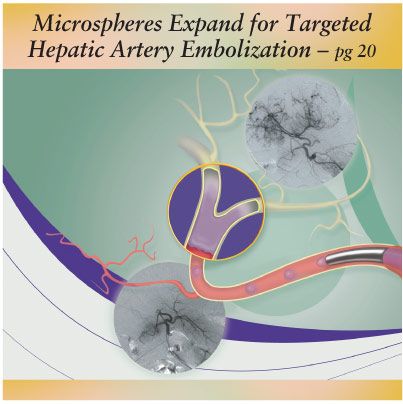Bland Microsphere Embolization Controls HCC
Nonchemotherapeutic (bland) embolization with superabsorbent polymer microspheres can provide prolonged control of hepatocellular carcinomas (HCCs) in the majority of patients
SEATTLENonchemotherapeutic (bland) embolization with superabsorbent polymer microspheres can provide prolonged control of hepatocellular carcinomas (HCCs) in the majority of patients, new data show.
The superabsorbent microspheres (QuadraSpheres in the United States, HepaSpheres in Europe; BioSphere Medical, Rockland, Massachusetts) are composed of a copolymer of sodium acrylate and vinyl alcohol, Shinichi Hori, MD, said at the 32nd Annual Meeting of the Society of Interventional Radiology (abstract 150). They are spherical in shape, available in dry-state sizes ranging from 50 to 350 &mgr;m, expand in various fluids, are nonresorbable, and have limited toxicity. The microspheres expand to two times their dry size when mixed with ionic contrast medium and to four times their dry size when mixed with human serum (see drawing).

Patients with previously untreated HCC were eligible for the study if they had large tumors, had poor hepatic or overall function, or declined chemotherapy, said Dr. Hori, director of the Gate Tower Institute for Image Guided Therapy, Osaka, Japan. The investigators performed selective bland embolization by advancing a microcatheter into the hepatic artery as close as possible to the tumor and injecting microspheres ranging in dry-state sizes from 50 to 100 &mgr;m mixed with ionic contrast material into each pedicle vessel supplying the tumor. The aim was angiographic vascular occlusion, Dr. Hori stated.
After embolization, the patients underwent follow-up by CT imaging. Thereafter, they underwent repeated bland embolization as needed to achieve tumor control, with the option of switching to chemoembolization if control could not be achieved.
A total of 82 patients were treated. "Pain was almost negligible, fever was well controlled by NSAIDs, and there was no need for antibiotics prior to and during the treatment course," Dr. Hori said. Moreover, he noted, liver function tests did not deteriorate in the month after bland embolization.
At 1 month, 76% of patients had a reduction in tumor size. Specifically, there was complete elimination or necrosis in 18 cases (22%) and 50% or greater size reduction or necrosis in 44 cases (54%). The duration of treatment with bland embolization alone was longer than 6 months in 50 of 82 patients (61%) and longer than 1 year in 35 of 55 patients (64%).
Survival Results
Estimated survival was 95%, 74%, and 50% at 1, 2, and 3 years, respectively, Dr. Hori said. Survival did not differ significantly according to baseline Child-Pugh classification (A, B, and C). "This means that even patients who have poor liver function can be treated with this protocol," he commented. In contrast, survival was significantly poorer for patients with invasion of the portal vein at baseline. "This means that this protocol is not recommended for patients who have portal vein invasion," he said.
Dr. Hori noted that "bland embolization with HepaSpheres [QuadraSpheres] has fewer complications than conventional methods. . . . More than 60% of the patients were controlled by this protocol for longer than 1 year." In conclusion, he said that bland embolization using QuadraSpheres is a safe and effective initial treatment method for HCC, except for patients with portal vein invasion.
Disclosures:
Bland Microsphere Embolization Controls HCC